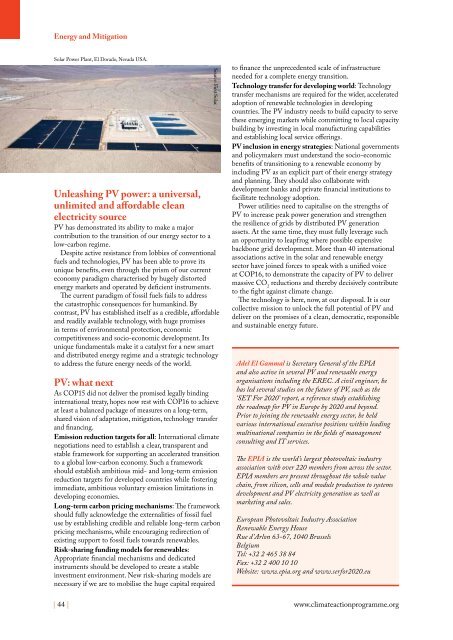Climate Action 2010-2011
Create successful ePaper yourself
Turn your PDF publications into a flip-book with our unique Google optimized e-Paper software.
Energy and Mitigation<br />
Solar Power Plant, El Dorado, Nevada USA.<br />
Unleashing PV power: a universal,<br />
unlimited and affordable clean<br />
electricity source<br />
PV has demonstrated its ability to make a major<br />
contribution to the transition of our energy sector to a<br />
low-carbon regime.<br />
Despite active resistance from lobbies of conventional<br />
fuels and technologies, PV has been able to prove its<br />
unique benefits, even through the prism of our current<br />
economy paradigm characterised by hugely distorted<br />
energy markets and operated by deficient instruments.<br />
The current paradigm of fossil fuels fails to address<br />
the catastrophic consequences for humankind. By<br />
contrast, PV has established itself as a credible, affordable<br />
and readily available technology, with huge promises<br />
in terms of environmental protection, economic<br />
competitiveness and socio-economic development. Its<br />
unique fundamentals make it a catalyst for a new smart<br />
and distributed energy regime and a strategic technology<br />
to address the future energy needs of the world.<br />
PV: what next<br />
As COP15 did not deliver the promised legally binding<br />
international treaty, hopes now rest with COP16 to achieve<br />
at least a balanced package of measures on a long-term,<br />
shared vision of adaptation, mitigation, technology transfer<br />
and financing.<br />
Emission reduction targets for all: International climate<br />
negotiations need to establish a clear, transparent and<br />
stable framework for supporting an accelerated transition<br />
to a global low-carbon economy. Such a framework<br />
should establish ambitious mid- and long-term emission<br />
reduction targets for developed countries while fostering<br />
immediate, ambitious voluntary emission limitations in<br />
developing economies.<br />
Long-term carbon pricing mechanisms: The framework<br />
should fully acknowledge the externalities of fossil fuel<br />
use by establishing credible and reliable long-term carbon<br />
pricing mechanisms, while encouraging redirection of<br />
existing support to fossil fuels towards renewables.<br />
Risk-sharing funding models for renewables:<br />
Appropriate financial mechanisms and dedicated<br />
instruments should be developed to create a stable<br />
investment environment. New risk-sharing models are<br />
necessary if we are to mobilise the huge capital required<br />
| 44 |<br />
Source: First Solar.<br />
to finance the unprecedented scale of infrastructure<br />
needed for a complete energy transition.<br />
Technology transfer for developing world: Technology<br />
transfer mechanisms are required for the wider, accelerated<br />
adoption of renewable technologies in developing<br />
countries. The PV industry needs to build capacity to serve<br />
these emerging markets while committing to local capacity<br />
building by investing in local manufacturing capabilities<br />
and establishing local service offerings.<br />
PV inclusion in energy strategies: National governments<br />
and policymakers must understand the socio-economic<br />
benefits of transitioning to a renewable economy by<br />
including PV as an explicit part of their energy strategy<br />
and planning. They should also collaborate with<br />
development banks and private financial institutions to<br />
facilitate technology adoption.<br />
Power utilities need to capitalise on the strengths of<br />
PV to increase peak power generation and strengthen<br />
the resilience of grids by distributed PV generation<br />
assets. At the same time, they must fully leverage such<br />
an opportunity to leapfrog where possible expensive<br />
backbone grid development. More than 40 international<br />
associations active in the solar and renewable energy<br />
sector have joined forces to speak with a unified voice<br />
at COP16, to demonstrate the capacity of PV to deliver<br />
massive CO 2<br />
reductions and thereby decisively contribute<br />
to the fight against climate change.<br />
The technology is here, now, at our disposal. It is our<br />
collective mission to unlock the full potential of PV and<br />
deliver on the promises of a clean, democratic, responsible<br />
and sustainable energy future.<br />
Adel El Gammal is Secretary General of the EPIA<br />
and also active in several PV and renewable energy<br />
organisations including the EREC. A civil engineer, he<br />
has led several studies on the future of PV, such as the<br />
‘SET For 2020’ report, a reference study establishing<br />
the roadmap for PV in Europe by 2020 and beyond.<br />
Prior to joining the renewable energy sector, he held<br />
various international executive positions within leading<br />
multinational companies in the fields of management<br />
consulting and IT services.<br />
The EPIA is the world’s largest photovoltaic industry<br />
association with over 220 members from across the sector.<br />
EPIA members are present throughout the whole value<br />
chain, from silicon, cells and module production to systems<br />
development and PV electricity generation as well as<br />
marketing and sales.<br />
European Photovoltaic Industry Association<br />
Renewable Energy House<br />
Rue d’Arlon 63-67, 1040 Brussels<br />
Belgium<br />
Tel: +32 2 465 38 84<br />
Fax: +32 2 400 10 10<br />
Website: www.epia.org and www.serfor2020.eu<br />
www.climateactionprogramme.org












